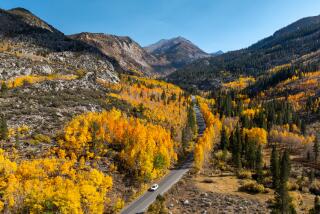A History in Ice
Naturalist John Muir marveled that the Sierra Nevada and Yosemite Valley were sculpted by massive glaciers created by the gently falling flakes that he called “snowflowers.” Storm after storm, flakes piled up until their weight turned the snow into ice. At the height of the Ice Age, California’s mountains were covered by flowing streams of ice up to 60 miles long. Even the higher peaks of Southern California’s San Bernardino Mountains were flanked by glaciers.
Over time, the glaciers retreated and disappeared. Now, a new analysis of polar ice fields indicates the Earth went through a rapid warming process about 12,500 years ago that put a quick end to the last great Ice Age. John White of the University of Colorado, writing in the journal Science, says average polar temperatures increased as much as 59 degrees within 50 years. That sort of dramatic evidence demonstrates the need for intensified research into the causes of climate change and the potential for rapid variations in the future.
But the warm spell that White writes about did not finish California’s glacial history. A little Ice Age beginning about 700 years ago brought glaciers back to California’s Sierra Nevada and to Mt. Shasta and the Trinity Alps in far Northern California. That ice advance peaked about 1900, and the remnants of these glaciers still exist high on the mountain flanks, continuing the geologic sculpting process.
The history of the California glaciers and a description of existing ones is contained in a new book published by the University of California Press as part of its California natural history guides series. The richly illustrated volume is “Glaciers of California” by Bill Guyton, professor emeritus of geosciences at Chico State and a veteran High Sierra hiker. Guyton reports there are 108 glaciers remaining in the California mountains, including nine on Mt. Shasta and 99 in the Sierra Nevada.
Additionally, there are 401 “glacierets,” defined as very small glaciers or ice patches that may or may not fit the traditional definition of a glacier. Two of these are in the Trinity Alps.
The Whitney Glacier on Mt. Shasta, named for early state geologist Josiah D. Whitney, is the largest, about two miles long and 126 feet thick. It flowed down to as far as the 9,500-foot level of Shasta in 1895 but lost more than half its ice between 1920 and 1935. The Whitney Glacier expanded again between 1944 and 1972.
The largest Sierra glacier is the half-square-mile Palisade Glacier west of Big Pine, clearly visible to motorists traveling U.S. 395. There are no true glaciers on the state’s highest peak, 14,495-foot Mt. Whitney. It is too far south and doesn’t receive enough snow.
What is the fate of California’s glaciers? Perhaps extinction again, if predictions of global warming are correct. But Guyton says it’s too soon to tell. The story of the California glaciers indicates that climate changes can be surprisingly sudden. It’s a story California needs to study more diligently as it plans for a future marked by dramatic social growth.
More to Read
Sign up for Essential California
The most important California stories and recommendations in your inbox every morning.
You may occasionally receive promotional content from the Los Angeles Times.









